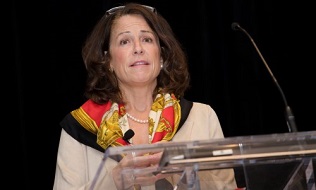

Automatic solutions in plan design can help fiduciaries to fulfil their obligations to defined contribution plan members, according to Ruthann Pritchard, an institutional portfolio manager at Fidelity Investments.
Speaking at Benefits Canada’s Defined Contribution Investment Forum in Toronto this month, Pritchard explained that the fiduciary duty owed by plan sponsors demands that they act in their members’ best interests.
“As plan sponsors, you need to design a plan that can actually set your member up for retirement success. Default them into the plan as soon as they are hired and at a high contribution rate to start them off saving meaningfully from Day 1. Implement automatic increase to annually increase their contributions to the plan. Lastly, default members into an appropriate asset allocation that will progress with them as they age,” she said.
Read: Employers encouraged to focus on the entry, exit points of DC plans
“Auto solutions really do work,” she added.
In the United States, Pritchard said the landmark 2006 Pension Protection Act gave businesses the “fiduciary cover” to automatically enrol their workers in their plans. However, the typical contribution of three per cent wasn’t high enough to achieve successful retirement outcomes, said Pritchard. Today, plan sponsors are increasingly enrolling members at six per cent, a rate she suggested is a best practice.
“Forty years of savings has to fund approximately 30 years of retirement. You cannot save your way to retirement, nor can you just invest,” she said. “A successful retirement requires a combination of meaningful savings and appropriate asset allocation over very long periods of time.”
In more recent years, Prtichard said sponsors have begun to embrace automatic increases that raise contribution rates annually.
“Once you’ve brought members’ contributions up to the level of the company match, increasing their contributions further doesn’t cost your company anything but it can dramatically improve member outcomes,” she said. “When you look at the amount of savings that are going into DC plans, particularly for the millennials who experienced this auto-solution wave, it’s markedly different. The account balances and savings habits today look entirely different than the 20-somethings of 10 years ago.”
Read: Leveraging technology to help plan members grasp the other side of the retirement equation
From a fiduciary point of view, Pritchard said target-date funds can also be useful for sponsors, since experience shows that, left to their own devices, members select inappropriate asset allocations that are “not going to get them to retirement readiness.”
Pritchard suggested, however, that plan sponsors must take care in the selection of a target-date fund and the particular glide path it employs to shift its mix of equities and fixed income over time.
“The selection of a glide path is very much an active decision. Plan sponsors need to engage in a dialogue with their consultants and target-date fund providers to ensure that they understand the risk and reward trade-offs that are being made along the glide path. Every glide path is different, and understanding the drivers and research behind is a key part of fiduciary due diligence.”
Read more articles from the 2017 DC Investment Forum
